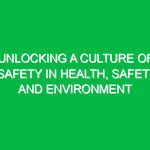In every work Environment, the Safety and health of employees are paramount. This is particularly true in the Health, Safety, and Environment (HSE) domain, where the stakes can be incredibly high. Health work Safety encompasses a wide range of practices and Regulations aimed at protecting workers from Hazards that could impact their well-being. In this article, we will explore essential health work safety tips that not only comply with HSE Standards but also foster a culture of safety and well-being among your team.
Understanding Health Work Safety in the HSE Context
Health work safety refers to the policies, procedures, and practices designed to prevent accidents and injuries in the workplace. This concept is crucial within the HSE framework, which emphasizes not only the physical safety of workers but also their mental and emotional health. A comprehensive health work safety program is built on identifying potential Hazards, implementing preventive measures, and creating an environment where employees feel valued and secure.
Effective health work safety practices can lead to numerous Benefits for both employees and employers. These include reduced accident rates, lower insurance costs, improved employee morale, and enhanced productivity. However, achieving these benefits requires commitment, ongoing Training, and a proactive approach to health and safety management.
Key Components of Health Work Safety
1. Hazard Identification and Risk Assessment
The first step in ensuring health work safety is identifying potential hazards in the workplace. This can range from physical hazards, such as machinery and chemicals, to ergonomic risks associated with repetitive tasks. Conducting regular risk assessments helps to identify these hazards and evaluate the risks they pose to employees.
For instance, consider a manufacturing facility where heavy machinery is operated. A thorough risk assessment might reveal that operators are at risk of injury from moving parts or falling objects. By addressing these risks through safety guards or Personal Protective Equipment (PPE), the organization can significantly reduce the likelihood of accidents.
2. Implementing Safety Protocols
Once hazards have been identified, the next step is to develop and implement safety protocols. These protocols should outline the Procedures employees must follow to mitigate risks. For example, in a laboratory setting, strict protocols for handling hazardous materials must be established. This includes proper labeling, storage, and disposal methods to ensure that employees are protected from chemical exposure.
Real-life example: A healthcare facility may implement strict hand hygiene protocols to prevent the spread of infections. Employees are trained on proper handwashing techniques, and compliance is regularly monitored. This not only protects staff but also the patients they serve.
3. Training and Education
Training is a cornerstone of effective health work safety. Employees must be educated about the hazards they may encounter and the appropriate measures to take. Regular training sessions, workshops, and drills are essential to reinforce safety practices and ensure that all team members understand their roles in maintaining a safe work environment.
For instance, fire safety training should not only cover the use of fire extinguishers but also Evacuation Procedures and emergency response plans. Engaging employees in hands-on training can enhance retention and ensure that they are prepared for real emergencies.
4. Personal Protective Equipment (PPE)
PPE is a critical element of health work safety. Depending on the nature of the work, employees may require different types of protective gear, such as helmets, gloves, goggles, or respirators. It is essential that employers provide the appropriate PPE and ensure that employees are trained in its proper use.
Moreover, regular checks should be conducted to ensure that PPE is maintained and replaced as necessary. For example, in a construction setting, workers should be equipped with hard hats and reflective vests to protect them from head injuries and increase visibility on-site.
5. Creating a Safety Culture
A strong safety culture is vital for promoting health work safety. This involves fostering an environment where safety is prioritized, and employees feel comfortable reporting hazards or unsafe conditions without fear of retaliation. Encouraging open communication about safety concerns can lead to proactive measures that prevent accidents.
For instance, a company might implement a safety committee composed of employees from various departments. This committee can meet regularly to discuss safety issues, review incident reports, and recommend improvements. This inclusive approach not only enhances safety but also empowers employees to take ownership of their well-being.
Legal Regulations and Standards
Compliance with health work safety regulations is not merely a best practice; it is a legal obligation. Various laws and standards govern Workplace Safety, including the Occupational Safety and Health Administration (OSHA) regulations in the United States and the Health and Safety at Work Act in the UK. Understanding these regulations is crucial for any organization aiming to protect its employees.
For example, osha requires employers to provide a workplace free from recognized hazards, which includes implementing Safety Measures and providing necessary training. Failure to comply can result in significant fines and legal consequences, not to mention the potential harm to employees.
Conclusion
In conclusion, health work safety is an integral part of the HSE framework that significantly impacts the well-being of employees and the overall success of an organization. By focusing on key components such as hazard identification, safety protocols, training, PPE, and fostering a safety culture, employers can create a safe working environment that protects their teams.
As we move forward, it is essential to remain vigilant and proactive in our approach to health work safety. Regularly reviewing policies, conducting training, and promoting open communication about safety concerns can lead to a healthier, safer workplace. Remember, investing in health work safety today not only protects your team but also contributes to a sustainable and successful future for your organization.


